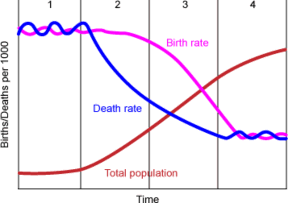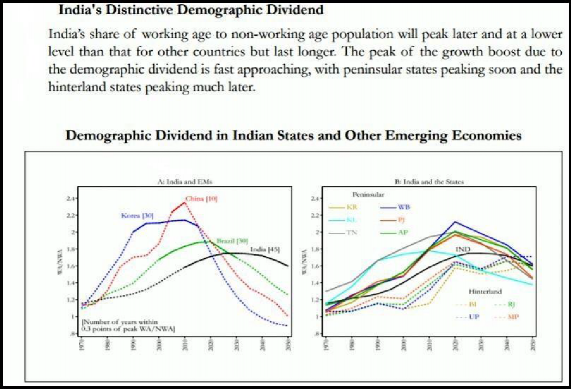Stage 4: Post-transition
Post-transitional societies are characterized by low birth and low death rates. In fact, birth rates may drop to well below replacement levels. So, population growth is negligible, leading to a phenomenon of shrinking population (like in Japan and Germany)

5.1. Demographic Dividend
Demographic dividend occurs when the proportion of working people in the total population is high because this indicates that more people have the potential to be productive and contribute to growth of the economy.
More than 63% of the population in India is in the age group of 15-59 years, broadly termed as
India’s demographic dividend.

♤ As per Sample Registration System (SRS) (2013) data, the proportion of economically active population (15-59 years) or, India’s ‘demographic dividend’, has increased from 57.7 to 63.3 per cent during 1991 to 2013. On account of better education, health facilities, and increase in life expectancy, the percentage of elderly (60+) has gone up from 6.0 to 8.3 per cent respectively in the same period.
♤ The growth rate of the labour force will continue to be higher than that of the population until 2021. According to an Indian Labour Report (Time Lease, 2007), 300 million youth will enter the labour force by 2025, and 25 per cent of the world’s workers in the next three years will be Indians.
♤ It is projected that by 2020 the average age of India’s population will be the lowest in the world—around 29 years compared to 37 years in China and the United States of America, 45 years in West Europe, and 48 years in Japan. Consequently, while the global economy is expected to witness a shortage of young population of around 56 million by 2020, India will be the only country with a youth surplus of 47 million (Report on Education, Skill Development and Labour Force (2013-14) Volume III, Labour Bureau,
This working age group must support itself as well as those outside this age group (i.e., children and elderly people) who are unable to work and are therefore dependents. Changes in the age structure due to the demographic transition lower the ‘dependency ratio’, or the ratio of non- working age to working-age population, thus creating the potential for generating growth.
But this potential can be converted into actual growth only if the rise in the working age group is accompanied by increasing levels of education and employment. If the new entrants to the labour force are not educated then their productivity remains low. If they remain unemployed, then they are unable to earn at all and become dependents rather than earners. Thus, changing age structure by itself cannot guarantee any benefits unless it is properly utilised through planned development. Strategies exist to exploit the demographic window of opportunity that India has today. But India’s recent experience suggests that market forces by themselves do not ensure that such strategies would be implemented. Unless a way forward is found, we may miss out on the potential benefits that the country’s changing age structure temporarily offers.

According to the United National population research, during the last four decades the countries of Asia and Latin America have been the main beneficiaries of the demographic dividend. Advanced countries of Europe, Japan and USA have an ageing population because of low birth rates and low mortality rates. Neither the least developed countries nor the countries of Africa have as yet experienced favourable demographic conditions according to the research by UN population division. China’s one child policy has reversed the demographic dividend it enjoyed since the mid 1960s according to a World Bank global development report.

Source: Economic Survey 2016-17
